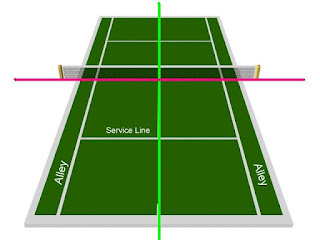
Ahhh, the ball pickup - sometimes the bane of lesson time. It does serve a purpose. After all, those balls aren't going to load themselves back in the cart. It provides a brief rest period and logical time to stop, get a drink, and discuss previous or future activities. However, if not managed properly, it can eat into valuable instruction time and at its worst devolve into a battle of wills. Instructors are always looking for fresh ways to get this done. At first the kids are all excited about the pickup, wanting to get it done quickly, trying to beat each other out for fastest pickup or most balls picked up. But the honeymoon is over fairly quickly. Dawdling, dilly-dallying, and outright dodging of responsibility soon sets in. Some coaches penalize the dodgers; for instance, if one is caught dodging during one pickup, said dodger is responsible for all balls at the next pickup. I have resorted to this on occasion, but I much prefer motivation to punishment. Here are some tactics that work for me.

Racquet pickup contest - an ongoing challenge to see who can beat either my personal best or the PB of another class in number of balls balanced one one racquet. Last count was 41 balls by one of my older classes. Younger classes usual run in the mid-20 ball range. Winners get their pictures on our FB page.
Timed pickups - divide players into teams responsible for specific halves or parts of the court. All balls must be picked up by a specific and brief time (seconds/low number of minutes).
Variation: time every pickup; every class competes to have quickest pickup.
Onesies - balls must be picked up by hand and deposited in hopper one at a time, at a brisk pace. A good workout!
Kangaroo pickup - if their shirts are loose enough, have them stuff their shirts with tennis balls. This is easier for the younger students than balancing on a racquet. Beware one unanticipated side effect (and in retrospect it shouldn't have been unanticipated) - one student picking up foam balls insisted they were her 'breasts' and she only wanted to pick up two at a time. She was 4. . . An alternative to this, again if the shirt is large enough, is have them use the shirt like an apron and carry the balls on the outside rather than stuffing them inside.
Fun pickup toys - got this from a
USTA QuickStart Workshop years ago - purchase some inexpensive plastic beach/Easter basket buckets. Cheaper than tubes and easier for young students to handle. Get lots of different colors. Large cones also work well for this.
Siblings assist - if younger siblings are on the outside looking in, invite them inside the court to help with the pickup.
Rollerball - Here's another fun and simple ball pickup activity. I found it in one of USTA's QuickStart Coaches Resource booklets. Have the players roll balls to the cart. Player with ball landing closest to cart wins. My students always want to know: what do we win? My answer: RESPECT.
Lobster Pickup - extra racquets needed for this one. Using 2 racquets, sandwich ball(s) between racquets to move them to the hopper/cart.
Tennis Ball Sandwich - have players work together in teams of 2, again with the sandwich idea before depositing ball into cart.
Ken's Pick-up - from Ken DeHart - Player performs a physical activity such as a lunge, squat, jumping jack, etc. after picking up a set number of balls; i.e. do one lunge for every 5 balls picked up.
 Two players in alley across net from each other. First player has 10 balls. Second player lays his/her racquet down to extend the service line across the alley. First player bounce feeds ball across net. Second player shags balls after one bounce, keeps score. 1 point for ball over net in front of racquet; 2 points for hitting racquet; three points for ball landing beyond racquet. All balls must land in alley. When balls run out, switch tasks. Whoever earns the most points with their allotted 10 balls wins.
Two players in alley across net from each other. First player has 10 balls. Second player lays his/her racquet down to extend the service line across the alley. First player bounce feeds ball across net. Second player shags balls after one bounce, keeps score. 1 point for ball over net in front of racquet; 2 points for hitting racquet; three points for ball landing beyond racquet. All balls must land in alley. When balls run out, switch tasks. Whoever earns the most points with their allotted 10 balls wins.








